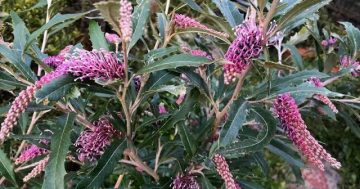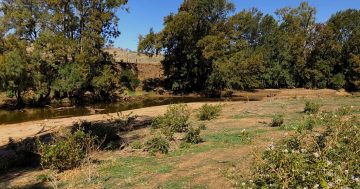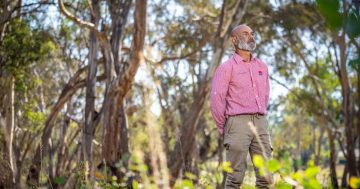
The Bathurst purple copper butterfly is a threatened species and researchers are investigating its range. Photo: David Roma, DPE.
Residents and visitors to the Snowy Monaro and other south-east parts of NSW are encouraged to look out for a colourful, threatened species.
They can also assist the NSW Local Land Services (LLS) to undertake a count of the species by reporting sitings to their local LLS office.
The purple copper butterfly (Paralucia spinifera) is a small species with a thick body and a wingspan of only 20-30 mm.
The upper sides of its wings are purple, black or deep brown, with a bronze or green iridescence when they’re in the sun.
The undersides of its wings are patterned with subtle brown, black and grey. Its black antennae are dotted with white spots and have a black tip.
Adults usually fly on warm sunny days between mid-August and November, mostly around the middle of the day (between 10 am and 3 pm).
Adult males fly rapidly at about one metre from the ground and rest in the sun with their wings parted.
Females fly less rapidly and tend to stay closer to the host plant, on which they lay their eggs.
Typical behaviours include territorial chasing and spiralling courtship chases, with one female being pursued by several males. They also like to sit in the sun and feed at nearby flowers.
Caterpillars grow to about 22 mm in length and are light green with darker longitudinal markings.
They are nocturnal and can be found crawling along the blackthorn stems and feeding on the leaves from 10 pm to 5 am between November and January.
They will be attended by between one and 15 ants, with other ants patrolling a line between the feeding caterpillar and the ant nest at the base of the plant; ants also roam around the host plant, attacking other insects that they find.
The purple copper butterfly is found in the area bordered by Bathurst, Portland, Lithgow and Oberon in the central tablelands of NSW, with an outlying population at Mount David and recently within Namadgi National Park, ACT.
It is also likely to occur in new areas yet to be discovered across NSW and ACT.
It is one of Australia’s rarest butterfly species.
The following features are common to known sites:
• Altitude greater than 850 m
• Presence of native blackthorn (Bursaria spinosa subsp. lasiophylla)
• Presence of attendant ant (Anonychomyrma itinerans)
• Heavy frosts and/or occasional snow
• Three to four hours’ exposure to direct spring sunlight.
Native blackthorn (Bursaria spinosa subsp.lasiophylla) is the only food plant of the purple copper butterfly.
Conserving the small areas of blackthorn that remain is critical to saving the butterfly from extinction.
Native blackthorn is an erect, spindly, often multi-stemmed shrub that generally grows to about two metres high. It has spines along the primary branches, and the dark-green foliage is sometimes sparse.
The native blackthorn is most obvious in spring to summer when mass flowering occurs on the outer branches.
The small white to cream flowers have a strong fragrant perfume that attracts a range of insect pollination.
Blackthorn grows at high elevation sites, and on heavier clay soils, in eucalypt woodlands throughout south-eastern Australia.
In the central tablelands of NSW, stands of blackthorn occur in remnant woodland areas along roadsides, in various Crown lands and on private property.











